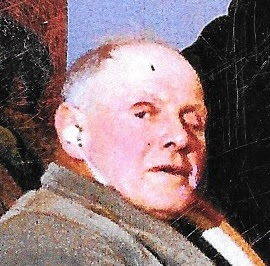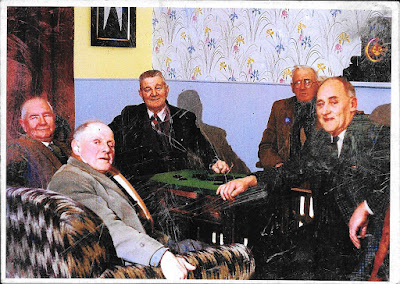 |
| Alexander 'Ecky' Black |
'Ecky' Black had suffered from a childhood illness that resulted in a leg having to be amputated just above the knee. Whether an artificial leg was too expensive, given that as a boy, he would have several as he grew to adulthood, or if he just elected not to wear a prosthesis, he always wore his trouser leg pinned up throughout his adult life. Thus making him instantly recognisable on the streets of Earlston with his crutch and walking stick and making him an unlikely choice as the village bellman. Nonetheless, he was Earlston's last bellman, a Scottish equivalent to a town crier but with its origins in religious belief.
In the seventh century, the church required that a bell be rung when a person died. It also stipulated that a bell be rung when someone was excommunicated to signify that person's spiritual death.
There was a belief that devils lay in wait to attack the soul of the dead person at the moment the soul departed the body. It was also believed that the sound of the bell terrified these devils.
After the Reformation, the interpretation changed, and the purpose of the bell ringing was to encourage the living to offer up prayers for the recently deceased.
Since the church now levied a charge to ring the bell, not everyone could afford the service; those who were privileged were willing to pay the fee, providing the church with a considerable income.
Different towns had different requirements for the bellman. In some towns, the bellman would walk the street tinkling a small bell, head uncovered, making the announcement, 'I hereby take you to wit that …, our brother (or sister) departed this life at … of the clock, according to the pleasure of the Lord.'
In Jedburgh, the bellman was required to keep his head covered and to make this announcement immediately after the death, regardless of the time of day.
In Hawick and other places, the bellman would invite people to go to the deceased's house and offer prayers after the intimation. The bellman would also visit the home to place the bell on the bed where the corpse was lying until the corpse was removed for burial.
Sometimes, a 'lykewake' or body watch took place during the nights between the death and the burial.
In some places, for instance, Polwarth, the bell was carried at the front of the funeral procession to 'frighten away the evil spirits’. Female relatives walked behind the procession until they reached the gate to the churchyard, where they always stopped and dispersed.
Bells have long been associated with death. The seventeenth-century poet and clergyman John Donne is credited with coining the phrase 'for whom the bell tolls', meaning that the funeral bell that tolls for another person's death, then, also tolls for us, in a sense, because it marks the death of a part of us, but also because it is a reminder that we will die one day.
But an incident in Chirnside may have started a fashion that brought new meaning to tolling bells.
There is a tale associated with a grave in the kirkyard of Chirnside. When Margaret Halcrow, second wife of the Reverend Henry Erskine, died in 1674, a few months after their marriage, she was carried to the grave and interred with a valuable ring still on her finger, a fact noted by the village sexton. After the funeral service, when only a light covering of earth was placed over the coffin, the sexton returned to the kirkyard to dig up the grave and remove the ring. It was so hard to remove it from the corpse's finger that he used his knife and began the task of cutting the digit off. As he did so, the corpse sat up in the coffin, screamed, then dashed across the kirkyard to the manse, where she shouted for the minister to open the door, 'For I'm fair clemmed wi' the cauld.' The wife lived a fair number of years after that, giving birth to Ralph and Ebenezer Erskine, founders of the Secession Church. (1)
The story of Margaret Erskine became a folklore theme to be cannibalised with different names and different locations. (2)
Declaring a person dead should have been straightforward for the doctors of the day. Nonetheless, people were fearful that they may be buried alive. This fear became increasingly common in the mid-1880s when American author Edgar Allan Poe published a horror short story, 'The Premature Burial', in which the main character develops a phobia about being buried alive. Enterprising businessmen were keen to cash in on this fear and offered 'safety coffins' to ease people's fear.(3)
 |
Franz Vester's "improved burial-case," U.S. Patent No. 81,437, issued Aug. 25, 1868 in Newark, New Jersey. |
Those who could afford it could purchase coffins with an elaborate system of rope and pulleys connecting the coffin to a bell on the ground above the grave. Family members, or more likely paid people, stood guard over the grave for the first few days just in case the bell should be rung by the interred person. Hence, the phrase 'saved by the bell' and those who stood at the graveside were known to be on 'graveyard watch'.
After the Reformation, the church was keen that it be understood that the bellman's purpose was to announce a person's death rather than chase away evil spirits. About this time, many parishes incorporated the bellman's position with the grave digger to save money.
Latterly, the bellman's job focussed on public announcements.
In 1881, the Galashiels bellman was roused at around midnight to make announcements about missing children and raise volunteer searchers. The bellman made his rounds again at six o'clock to muster more searchers. The two girls, aged seven and eight, were found safe and well.(4)
Some bellmen took to selling their services. Walter Stiller, a Jedburgh bellman, went the round of the town and made the following announcement on his own behalf:
'Notice To merchants and the general public.—As I am slack, and every one else slack, and having nothing else that I can do than that of the bell - crying to while away some of my dark, weary hours, I have resolved to proclaim any one's goods through the town lost, found, or to sell—at 3d for the bell, 6d for the drum. All goods lost, and not found, no charge made. I have myself, in bygone days, employed men in this town, and I do not see why blindness should now shut out of existence. All orders strictly attended to.’ (5)
 |
| Bobby the Bellman, Jedburgh Town Crier Credit: Border Cavalcade |
A Selkirk bellman, Tom Murray, had a sense of civic duty. Before the First World War, he was asked to promote a 6½d Bazaar at the Volunteer Hall. Before he started out, however, he called into a local ironmonger who pointed out that he sold similar goods at a halfpenny less. That was enough for Tom. Round the town he went, ringing the bell and shouting:
Notice! A sale is being held in the Volunteer Hall. All articles are being sold at cost price, nothing over 6½d. You can get the same articles at 6d in Blank's, the ironmonger's, in High Street. God Save the King!'
This incident was reported in Tom's obituary in 1934. Apparently, a crowd of about 300 young men followed the bellman, and every announcement brought fresh roars of laughter. The bellman received no payment from the bazaar promoters.(6)
 |
| Alec Stainton, Hawick bellman Credit: Border Cavalcade |
Bellmen would be financed by town councils rather than the parish. Depending on how rich a town council was was determined by the standing of the bellman. Peebles, for example, was relatively affluent and kitted out its bellman with a uniform. Less well-off councils were content that the bellman discharged his duties in everyday clothes. Other concessions were made, e.g. Peebles supplied a drum rather than a bell, although he was still called `the bellman`. In Hawick, announcements were also preceded by the beating of the drum. Three surviving drums are on display at Hawick Museum.
 |
| John Rennie, Peebles Town Drummer Credit: Border Cavalcade |
We don't know when the role of bellman in Earlston was created, nor when the role was transferred from the church to the council. There are no photographs of Earlston bellmen. However, we do know that the Earlston bellman was never issued with a uniform and that Ecky was the last one and we also know something about the man.
Ecky, or Alexander Landell Black, was born in 1893 in Primrose Street, Leith, the second child of Archibald Black, a merchant seaman, and Alice Landell. Ecky's older brother, John, was also born there.
By 1901, the family had moved to Earlston. Archibald Black had jobs on the railway, first as a signalman, then as a porter. In Earlston, the Blacks would raise another five children - Jane, Archibald, Alice, Heriot and Jessie. Archibald would die in the First World War just days before the armistice was declared. He is buried in the Awoignt British Cemetery and commemorated on the Earlston War Memorial.
 |
| Ecky Black with friends in the Earlston Reading Room L to R: Bob Wilson, Ecky Black, George Rutherford, Bob Patterson, and Andrew Murdison Credit: Auld Earlston Collection |
Ecky died in 1968 at the Inch Hospital in Kelso and is remembered on the family gravestone in Earlston Cemetery.
Some Earlston residents still recall Ecky making civic announcements but his death marked the end of another aspect of village life.
Credits
1 Scottish Kirkyards, Love, Dane 1989 Published London, R Hale 1989
2 Scottish Folk Lore, Lamont-Brown, Raymond 1996 Published Edinburgh Birlinn, 1996
3 www.en.Wikipedia.org, Taphophobia
4 Southern Reporter, 04 August 1881
5 Souther Reporter 18 December
6 Southern Reporter 25 January 1934
7 Border Cavalcade 'Life a Century Ago', Moffatt, Frederick C, Published Newcastle-upon-Tyne, F C Moffatt 1980

